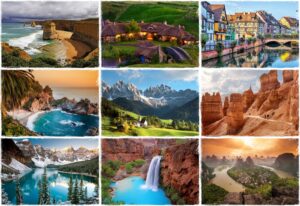The 7 Wonders of the World represent humanity’s greatest architectural and cultural achievements, standing as testaments to human ingenuity, creativity, and determination. These magnificent structures have captivated travelers for generations, drawing millions of visitors annually who seek to witness these ancient marvels and modern masterpieces firsthand.
Visiting the Seven Wonders of the World is more than just checking items off a bucket list—it’s a transformative journey through history, culture, and human achievement. From the ancient stone walls of Machu Picchu perched high in the Andes to the intricate marble inlays of the Taj Mahal, each wonder offers a unique glimpse into the civilizations that created them.
Planning a world wonders tour requires careful consideration of logistics, timing, and budget. Whether you’re planning to visit all seven in one epic journey or spread your visits across multiple trips, this comprehensive guide will provide you with essential information about how to visit the 7 Wonders of the World efficiently and meaningfully.
The modern New Seven Wonders of the World, selected through a global poll in 2007, include: the Great Wall of China, Petra in Jordan, Christ the Redeemer in Brazil, Machu Picchu in Peru, Chichen Itza in Mexico, the Roman Colosseum in Italy, and the Taj Mahal in India. Each destination presents unique challenges and rewards for travelers.
This travel guide will walk you through everything you need to know about visiting these incredible sites, from practical travel tips and best visiting seasons to cultural insights and photography advice. Whether you’re a seasoned traveler or planning your first international adventure, this guide will help you make the most of your wonders of the world travel experience.
Planning Your Seven Wonders Journey
Creating Your Travel Itinerary
Planning a 7 Wonders of the World trip requires strategic thinking about geography, seasons, and logistics. The most efficient approach is to group the wonders by continent and region, minimizing travel time and costs while maximizing your cultural immersion.
Consider starting with a South American route that combines Machu Picchu in Peru with Christ the Redeemer in Brazil. This allows you to experience two wonders while exploring the diverse landscapes and cultures of South America. Many travelers find that spending 2-3 weeks in this region provides ample time to acclimate to altitude changes and fully appreciate both destinations.
For European and Middle Eastern wonders, pair the Roman Colosseum in Italy with Petra in Jordan. This combination offers fascinating contrasts between European and Middle Eastern civilizations. Rome provides excellent flight connections to Jordan, making this a logical pairing for efficient travel.
The Asian wonders—the Great Wall of China and Taj Mahal in India—can be combined with visits to other regional highlights. Many travelers extend their Asian journey to include temples in Cambodia, beaches in Thailand, or cultural experiences in Japan.
Chichen Itza in Mexico can be visited as part of a broader Central American adventure or combined with other Mexican destinations like Cancun, Mexico City, or Oaxaca.
Budget Considerations for Wonder Tourism
Seven Wonders tourism costs vary significantly depending on your travel style, accommodation preferences, and the season you choose to travel. Budget travelers can expect to spend $150-300 per day per person, while luxury travelers might spend $500-1000+ daily.
Transportation typically represents the largest expense in a world wonders tour. International flights between continents can cost $500-2000 per segment, depending on booking timing and route efficiency. Consider purchasing round-the-world tickets or flexible multi-city itineraries that allow for changes.
Accommodation costs range from budget hostels at $20-50 per night to luxury hotels at $200-500+ per night. Many wonder locations offer mid-range options that provide comfort and cultural authenticity without breaking the budget.
Entry fees for the 7 Wonders of the World vary from $15-80 per site, with additional costs for guided tours, special access areas, or photography permits. Some sites offer package deals or multi-day passes that can provide savings for extended visits.
The Great Wall of China: Your First Wonder
Getting There and Around
The Great Wall of China stretches over 13,000 miles across northern China, with several sections accessible to tourists. The most popular section near Beijing is Badaling, easily reached by tour bus, train, or private transportation. For a less crowded experience, consider visiting the Mutianyu or Jinshanling sections.
Beijing serves as the primary gateway for Great Wall visits. The city’s two international airports, Capital International and Daxing International, receive flights from major cities worldwide. High-speed trains connect Beijing to other Chinese cities, making it easy to combine your Great Wall tour with visits to Shanghai, Xi’an, or other destinations.
Best Times to Visit
The best time to visit the Great Wall depends on your tolerance for crowds and weather. Spring (April-May) and autumn (September-October) offer mild temperatures and beautiful scenery, but expect larger crowds. Summer brings hot, humid weather and peak tourist season, while winter offers fewer crowds but cold temperatures and potential snow.
Early morning visits provide the best lighting for photography and smaller crowds before tour groups arrive. Sunrise visits require special arrangements but offer unforgettable experiences for dedicated photographers and early risers.
Cultural Significance and Tips
The Great Wall represents over 2,000 years of Chinese military engineering and cultural determination. Understanding its historical context enhances the visiting experience significantly. Consider hiring a knowledgeable local guide who can explain the wall’s construction techniques, historical battles, and cultural significance.
Wear comfortable hiking shoes with good grip, as many wall sections involve steep climbs and uneven stones. Bring water and snacks, especially for less developed sections where facilities are limited.
Petra: The Rose City of Jordan
Planning Your Petra Adventure
Petra, Jordan, requires at least two days to explore properly, though many visitors spend 3-4 days discovering its hidden treasures. The ancient Nabataean city carved into rose-colored rock faces offers countless photo opportunities and archaeological wonders.
Wadi Musa serves as the modern gateway to Petra, offering numerous accommodation options from budget hostels to luxury resorts. Book accommodations well in advance, especially during peak seasons (March-May and September-November).
Navigation and Must-See Sites
The Petra archaeological site covers a vast area, with the main trail stretching over 4 miles one way. Essential sites include the Treasury (Al-Khazneh), the Monastery (Ad Deir), the Royal Tombs, and the ancient theater. Budget full days for exploration, as rushing through Petra diminishes the experience significantly.
Consider purchasing the Jordan Pass, which includes Petra entry fees and visa costs, providing excellent value for international visitors. The pass also includes access to other Jordanian archaeological sites.
Practical Visiting Advice
Petra’s desert climate requires careful preparation. Bring sun protection, comfortable walking shoes, and plenty of water. Temperatures can vary dramatically between day and night, so layered clothing is essential.
Photography is permitted throughout Petra, but respect local customs and ask permission before photographing people. The Treasury and Monastery offer the most iconic photo opportunities, with best lighting in mid-morning and late afternoon.
Christ the Redeemer: Brazil’s Icon
Reaching Rio’s Summit
Christ the Redeemer in Rio de Janeiro stands atop Corcovado Mountain, accessible by cog train, van, or hiking trail. The Trem do Corcovado (Corcovado Train) provides a scenic 20-minute journey through Tijuca Forest, offering glimpses of local wildlife and vegetation.
Advanced booking is essential, especially during the Brazilian summer (December-March) and major holidays. The train operates daily but may suspend service during severe weather conditions.
Optimal Viewing Conditions
Weather conditions significantly impact the Christ the Redeemer experience. Rio’s tropical climate brings frequent clouds and rainfall, which can obscure the statue and city views. Monitor weather forecasts and consider flexible scheduling to maximize clear-sky opportunities.
Early morning visits often provide the clearest views before afternoon clouds roll in. Sunset visits offer dramatic lighting but may involve larger crowds and booking challenges.
Cultural Context and Surroundings
Christ the Redeemer represents Brazil’s strong Catholic heritage and artistic achievement. The 98-foot-tall statue, completed in 1931, required innovative engineering solutions and international collaboration. Learn about the statue’s construction history and religious significance to appreciate its cultural impact fully.
Combine your visit with exploration of Rio de Janeiro’s other attractions: Sugarloaf Mountain, Copacabana Beach, and the vibrant neighborhoods of Santa Teresa and Lapa.
Machu Picchu: The Lost City of the Incas
The Cusco Gateway
Machu Picchu requires careful planning due to limited daily visitor numbers and altitude considerations. Cusco serves as the primary access point, requiring 2-3 days for altitude acclimatization before visiting the ancient citadel.
Train services from Cusco or Ollantaytambo provide the most comfortable access to Aguas Calientes (Machu Picchu Pueblo), the base town for the archaeological site. Peru Rail and Inca Rail offer various service levels from budget to luxury.
Booking and Permits
Machu Picchu tickets must be purchased in advance, with specific time slots and circuit options. The Peruvian government limits daily visitors to preserve the site’s integrity. Book tickets 2-3 months ahead for peak season visits (May-September).
The Huayna Picchu mountain hike requires separate permits and books up quickly. This challenging climb offers spectacular aerial views of the main citadel but requires good physical fitness and proper hiking equipment.
The Complete Experience
Allow full days for Machu Picchu exploration. The site opens at 6:00 AM, with early entry providing opportunities for sunrise photography and smaller crowds. Different circuits offer varying perspectives and hiking challenges.
Consider extending your Peru adventure to include the Sacred Valley, Rainbow Mountain, or Amazon rainforest experiences. Many travelers combine Machu Picchu with multi-day treks like the Classic Inca Trail or alternative routes.
Chichen Itza: Mexico’s Mayan Marvel
Accessing the Yucatan Wonder
Chichen Itza in Mexico’s Yucatan Peninsula is easily accessible from Cancun, Merida, or Valladolid. Many visitors base themselves in beach destinations like Cancun or Playa del Carmen, taking day trips to the archaeological site.
Rental cars provide maximum flexibility for exploring multiple Yucatan sites, while organized tours offer convenience and expert guidance. The site is approximately 2 hours from Cancun and 1.5 hours from Merida.
Timing Your Visit
Early morning arrival is crucial for Chichen Itza visits, as the site becomes extremely crowded by midday. The archaeological zone opens at 8:00 AM, with the first hour offering the best conditions for photography and peaceful exploration.
The spring and fall equinoxes create special light phenomena on the Kukulkan Pyramid, drawing massive crowds but offering unique experiences for those willing to deal with congestion.
Beyond the Pyramid
While the Kukulkan Pyramid (El Castillo) dominates most photographs, Chichen Itza contains numerous other significant structures: the Great Ball Court, Temple of Warriors, and Sacred Cenote. Allow 3-4 hours for comprehensive exploration.
Nearby cenotes (natural sinkholes) offer opportunities for swimming and snorkeling, providing relief from Yucatan’s heat and humidity. Cenote Ik Kil and Cenote Dos Ojos are popular options for post-archaeological site activities.
Roman Colosseum: Eternal City’s Gladiator Arena
Rome’s Ancient Heart
The Roman Colosseum sits at the center of Rome’s ancient district, within walking distance of the Roman Forum, Palatine Hill, and other archaeological treasures. This proximity allows for a comprehensive ancient Rome in 2-3 days.
Skip-the-line tickets are essential during peak tourist season (April-October), as standard entry lines can exceed 2 hours. Various ticket combinations include access to the Colosseum, Roman Forum, and Palatine Hill.
Underground and Upper Levels
Special access tours to the Colosseum’s underground chambers and upper levels provide unique perspectives on ancient Roman engineering and gladiatorial spectacles. These tours require booking and cost more than standard entry but offer unforgettable experiences.
The underground areas reveal the complex system of tunnels, chambers, and elevators used to stage elaborate spectacles. Upper-level access provides panoramic views across Rome’s historic center.
Roman Context
Understanding ancient Roman society and gladiatorial culture enhances the Colosseum experience significantly. Consider guided tours that explain the social, political, and entertainment aspects of Roman spectacles.
Combine your Colosseum visit with other Roman archaeological sites: the Pantheon, Baths of Caracalla, and Ostia Antica. Rome’s excellent public transportation system makes exploring multiple ancient sites convenient and affordable.
The Taj Mahal: India’s Monument to Love
Agra Logistics
The Taj Mahal in Agra, India, requires careful planning due to its popularity and India’s complex logistics. New Delhi serves as the primary international gateway, with excellent train and road connections to Agra.
Same-day visits from Delhi are possible but rushed. Consider spending 1-2 nights in Agra to experience the Taj Mahal at different times and explore other Mughal monuments like Agra Fort and Fatehpur Sikri.
Optimal Viewing Times
Sunrise visits to the Taj Mahal offer magical lighting and smaller crowds, though they require very early morning departures from accommodations. The monument opens 30 minutes before sunrise, with tickets available for purchase at the gate.
Full moon nights provide special viewing opportunities once monthly, offering ethereal experiences of the white marble monument under moonlight. These sessions require advance booking and cost more than standard daytime visits.
Photography and Cultural Sensitivity
The Taj Mahal presents unlimited photography opportunities, but respect cultural sensitivities and monument preservation rules. Tripods require special permits, and certain areas restrict photography equipment.
Understanding the Taj Mahal’s history as Emperor Shah Jahan’s tribute to his deceased wife Mumtaz enhances appreciation for its architectural symbolism and artistic details. The monument represents the pinnacle of Mughal architecture and Indo-Islamic art.
Practical Tips for Wonder Tourism
Documentation and Visas
International travel to visit the 7 Wonders of the World requires careful attention to visa requirements, passport validity, and documentation. Many countries require visas obtained in advance, while others offer visa-on-arrival or electronic visa options.
Ensure your passport remains valid for at least six months beyond your intended travel dates, with sufficient blank pages for entry stamps and visas. Consider carrying backup copies of important documents stored separately from originals.
Health and Safety Considerations
Travel health preparation varies by destination, with some wonder locations requiring vaccinations or altitude acclimatization. Consult travel medicine specialists 6-8 weeks before departure to address health requirements and recommendations.
Travel insurance covering medical emergencies, trip cancellations, and lost luggage provides essential protection for multi-country wonder tours. Verify coverage limits and exclusions, especially for high-altitude destinations like Machu Picchu.
Photography and Technology
Capturing memories at the 7 Wonders of the World requires preparation for varying lighting conditions, weather challenges, and equipment limitations. Pack versatile camera equipment suitable for architectural photography, landscapes, and cultural documentation.
Consider portable chargers, universal adapters, and backup storage devices for electronic equipment. Many wonder locations have limited charging facilities, especially at remote archaeological sites.
Read More: Traveling On A Budget 10 Amazing Hacks That Actually Work
Conclusion
Visiting the 7 Wonders of the World represents one of travel’s ultimate achievements, offering unparalleled opportunities to witness human creativity, cultural diversity, and historical significance. Each wonder provides unique challenges and rewards, from the engineering marvel of the Great Wall of China to the architectural perfection of the Taj Mahal.
Successful wonder tourism requires careful planning, cultural sensitivity, and flexibility to adapt to changing conditions. The investment in time, money, and energy pays dividends in memories, photographs, and personal growth that last lifetimes.
Whether you complete all seven wonders in one epic journey or spread visits across multiple trips, each destination offers transformative experiences that broaden perspectives on human achievement and cultural diversity. The New Seven Wonders of the World serve as ambassadors for their respective countries and cultures, inspiring visitors to appreciate both our shared humanity and our diverse expressions of creativity.
Start planning your 7 Wonders of the World adventure today, and prepare for a journey that will forever change your understanding of human potential and cultural achievement.
FAQs
Q1: How much does it cost to visit all 7 Wonders of the World?
The total cost varies significantly based on travel style, but expect $15,000-50,000 per person for a comprehensive trip including flights, accommodations, meals, and site entry fees. Budget travelers can reduce costs through careful planning, while luxury travelers may spend considerably more.
Q2: What is the best time of year to visit all 7 Wonders of the World?
The optimal timing depends on your route and weather preferences. Generally, spring (April-May) and fall (September-October) offer the best balance of favorable weather and manageable crowds across most destinations. Consider planning a 2-3 month journey to accommodate seasonal variations.
Q3: Do I need special permits or bookings for the Seven Wonders?
Yes, several wonders require reservations: Machu Picchu has limited daily visitors requiring tickets 2-3 months ahead, Huayna Picchu mountain requires separate permits, and some Colosseum underground tours need booking. Christ the Redeemer train tickets should be reserved, especially during peak season.
Q4: How long should I spend at each of the 7 Wonders of the World?
Minimum recommended times: Great Wall (1 day), Petra (2-3 days), Christ the Redeemer (half day), Machu Picchu (1-2 days), Chichen Itza (1 day), Roman Colosseum (1 day), and Taj Mahal (1 day). However, spending additional time in each region allows for deeper cultural exploration and reduces travel fatigue.
Q5: Can I visit all 7 Wonders of the World in one trip?
Yes, though it requires significant planning, budget, and stamina. Most travelers spend 6-12 weeks on a comprehensive seven wonders tour, allowing time for travel between destinations, cultural exploration, and rest. Consider breaking the journey into multiple trips if time or budget constraints apply.









